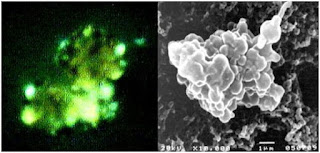Microorganisms
 what are microorganisms?
what are microorganisms?
You can see a large number of a living organisms around
you. however, do you know that there is a large number of living organisms around
you and inside your body that you cannot see with the naked eye? Activity-1
To observe microorganisms
Take a drop of a pond water and look at it carefully. can you see any living organisms in it? now put this drop of water on a glass slide and examine it under a light microscope. can you see many Tiny one- celled organisms floating or moving about swiftly?collect some more soil from a field. put it into a beaker. add some water to it and mix well. after the soil has settled down, observe a drop of water under a microscope. what do you see ?
scrape your tooth with toothpick and observe the scraping under a microscope. can you see tiny rod-like Organisms in it?
this activity shows that tiny organisms live in water, soil and even inside your body. these are so small that they cannot be seen with the naked eye. they are called the microorganisms or microbes.
organisms that are so small that they can be only see through a microscope, are called microorganisms or microbes.
these organisms have a great impact on human in a many ways. some causes diseases, whereas other cure them. some provide us food, whereas other spoil food.
the study of microorganisms is known as microbiology. scientist who study microorganisms are known as microbiologists.
where are microbes found?
most microorganisms are hardly and can be found in almost any kind of a environment. they are found in the hottest of deserts and in the coldest icy polar regions. some microbes live in cracks in the sea floor. some microorganisms can even survive a volcanic eruption. microorganisms are found in a salt water, in marshland and even inside your body.
microorganisms are hardly because they form a hard outer covering called cyst around themselves. they do this when a conditions are not favourable, such as under extreme conditions of temperature and dryness. they survive by remaining inactive with the cyst until conditions are favourable again.
types of microorganisms
there are five major group of microorganisms these are as follows:
- bacteria
- algae
- Protozoa
- Fungi
- virus
bacteria
 bacteria are simple and
unicellular living things. they are found almost everywhere-- in air, water ,soil and
in bodies of most other organisms, including human beings. they grow and multiply
very fast. one bacterium divides to form two bacteria in 10 to 30 minutes.
bacteria are simple and
unicellular living things. they are found almost everywhere-- in air, water ,soil and
in bodies of most other organisms, including human beings. they grow and multiply
very fast. one bacterium divides to form two bacteria in 10 to 30 minutes.nearly to 2,50,00,00,000 bacteria are present in 1 gram of a garden soil. each bacterial cell can exist singly, but sometimes they cling together to form chains or groups. bacteria found in three different shapes.
- rod-shaped, called bacilli
- spherical ,called cocci
- spiral ,called spirilla
Algae
almost
all algae live in water- in pond lake and sea water. some Algae are
found in snow and some in hot springs. they also grow in the moist soil,
barks of trees and rock surfaces. the green growth often seen in water
and
on the surface of wet rocks is Algae.
Protozoa
Protozoa are unicellular organisms that
have animal -like characteristics. they can move from one place to place .they
capture and eat food. some Protozoa live in freshor salt water. others live in a
soil. Some are parasites that live in the bodies of other organisms, including human
beings. Amoeba, Giardia and Paramecium and some example of Protozoa.
Fungi
fungi are plant-like organisms that do not contain chlorophyll. they may be unicellular or multicellular. yeast are unicellular, whereas bread mould is multicellular. mushrooms are large multicellular fungi. fungi cannot make their own food. they are either parasite and saprophytes ( saprophytes are organisms that feed on waste and dead plants and animals). though fungi are present everywhere, from deserts to very cold regions, they grow best in dark,warm and moist places .
viruses
viruses are the smallest microorganisms. they do not have a cellular structure like other microoganisms. they are so small that they cannot be seen by a light microscope. to observe viruses ,some scientist or an electron microscope which magnifies an object to more than 2,00,000 times.
viruses cannot reproduce by themselves, respond to changes or use energy or grow. this seems to indicate that viruses are not living organisms. however, when a virus enters the living cell of an organism, say a human it is able to reproduce. it uses the energy of the host cells for their purpose. after the formation of thousand of viruses, the host cell often dies. It burst and the new viruses spread and invade other cells. as a large number of host cells die,the person fall ill.
since reproduction is very important characteristic of life ,scientists regard viruses as a link between living and non-living. they have been placed on the dividing line between the living and non-living.
useful microorganisms
Microorganisms are useful in the following ways.- in a food and beverage industry
- in making medicine and vaccines
- in agriculture
- in cleaning the environment




0 Comments